Fishes have been an integral member of our food chain as far as the human history goes. With 97% of our planet under water, fishes were and are the most abundant resource for man and animal alike. The huge diversity, ease of availability and nutrient vitality are the three main reasons that fishes are a hit all across the globe. Fishes or to be more precise, sea food, enjoy a lot of prestige as ‘health food’ universally. Many esteemed organizations like American Heart Association, United States Food and Drug Administration (US FDA), Environmental Protection Agency (EPA) have issued statements in the last couple of years citing the benefits of having fishes on a regular basis.
However, you can’t just jump into the ocean and eat the first thing that you catch. So, let’s tell you all that you need to know about fishes. We will also help you with the best Indian fishes for a protein rich diet. So let’s dive into the nutritious world of marine animals.
Types of Fishes
With majority of area being under water, the effect of climate is more pronounced on the aquatic beings. To keep things simpler, we will classify fishes on a very broad index – type of water. Based on this we have:
- Fresh Water Fish
As the name suggests, these are the fishes that stay in fresh or non-saline water. In spite of the fact that fresh water on Earth is really limited, about 41% of total fishes we know of are found in fresh water.
India is pretty rich in terms of fresh water fishes. The two main fresh water fish zones in India are the Western Ghats and the North East. Some commonly consumed fresh water fishes are catfish, carp, crappie, bluegill or bream, trout, walleye, bass, drum etc. Fortunately, a lot of these are abundantly available in India.
- Salt Water Fish
As the name suggests, this type of fish survives in a salt rich or to be more specific, in a basic environment (around 8.2 pH). Almost 60% of the known marine species reside in the salty oceanic and sea waters.
India, being surrounded by the Indian Ocean and Arabian Sea, enjoys an impressive variety of salt water fishes. Almost all the widely consumed salt water fishes are found in India. Some of the most popular names are salmon, tuna, anchovies, sardines, snapper, cod, mackerel, pomfret, herring etc.
- Others
When it comes to edible marine animals, the list does not highlight only fishes. Some of the other marine animals that are an integral part of a seafood menu in India are prawns, shrimps, lobsters, squids, crabs, clams and oysters.
Benefits of having fish or seafood
- Rich in protein
- Low in saturated fats
- High in Omega 3 (essential fatty acids)
- Rich source of vitamins and minerals
Fishes provide a generous amount of protein without unnecessary saturated fats. As, we all know, high protein is essential for muscle development and energy production. Fishes are therefore, highly preferred by bodybuilders, athletes and fitness lovers as a source of protein. In addition, fishes are rich in Omega 3 fatty acids.
The three most important Omega 3 fatty acids are ALA (Alpha-linolenic acid), EPA (Eicosapentaenoic acid) and DHA (Docosahexaenoic acid). They are required by body for the development, structuring, maintenance and efficient functioning of major organs like brain, skin, heart etc.
Some of the most prominent benefits of having Omega 3 are:
- Helps in controlling blood pressure
- Prevents heart failure
- Prevents heart attacks
- Helps in weight management
- Is a great anti-inflammatory agent
- Helps in arthritis
- Essential for having a great skin
- Supports the mental development of young children
- Enhances cognitive functions
It has been stated that a normal adult should have at least two portions (140 grams each when cooked) of fish each week. Since Omega 3 has such a profound impact on the development of major organs including brain and cognitive functions, health experts insist that pregnant women and young children should have regular intakes of Omega 3. However, sea food comes with its risk as well and the vulnerable group i.e. pregnant ladies, lactating mothers and young children should be very careful with their choice of sea food.
Fish or seafood Contaminants – Mercury and More
The risk factor arising from fishes is due to the contaminants that they harbour in their bodies. On consumption, these toxic substances enter our bodies too. The contaminants usually found in fishes are:
Mercury:
Mercury is a naturally occurring element that becomes a part of fish food chain and gets stored in their flesh. Every fish therefore, contains some amount of mercury which in normal amounts does not pose a potential threat to us.
The only problem here is that more and more mercury is being released into the atmosphere due to human activities like energy generation, combustion etc. This mercury makes it way to the oceans where oceanic bacteria convert it to methyl-mercury. This is taken up by microorganisms that fishes feed on. Thus, fish meat is now home to methyl-mercury which is very toxic to humans in high concentrations. It has been observed that larger fishes (predators that consume other fishes) and fishes with longer life spans contain more mercury than smaller and shorter lived ones.
Other contaminant in fishes or seafood:
Due to industrial wastes and chemicals being washed into the oceans, the number of contaminants entering the oceanic food chain has increased. Worth mentioning here are heavy metals like lead, polychlorinated biphenyls (PCBs), chlordane and even DDT. Fishes that graze on the oceanic grounds (where these contaminants settle down), are more toxic than the others.
Risks and Precautions when consuming fishes or seafood
Health regulating bodies, advice the vulnerable group to stay away from high-mercury fishes altogether. They should consume a max of 340 grams of low mercury fish in a week. It is not recommended to abstain from fish altogether as omega 3 and protein are a necessity during pregnancy. They can protect the child from an array of illness and birth disorders.
Normal adults can have as much fish as they like as long as they are striking a balance between high and low level mercury fishes.
Keeping all the dos and don’ts in mind, here is our list of the Top 10 best Indian fishes or seafood for a protein rich diet. However, our selection will also consider the Omega 3 content and the mercury levels of these fishes so that it is a win-win situation for you.
1) Rawas (Indian Salmon)
Protein per 100 grams: 25 to 26 grams
Omega 3: 2260 mg
Mercury: Less than 0.09 ppm (Low Level)
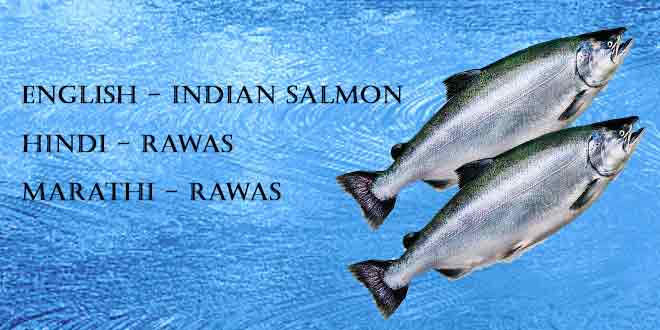
Salmon is one of the most popular edible fish. Rawas, as it is called in India, is a widely available fish popular for its pink to orange meat and mild flavour. Rawas is an oily fish i.e. it contains oil almost all over its body – tissues as well as the belly cavity. Approximately, a Salmon fillet (boneless piece of meat) contains around 30% of oil. This oil is rich in Omega 3, Vitamin A and Vitamin D.
Even though salmon is low in mercury, it might contain other contaminants like PCBs. So do not have salmon more than 170 grams in a week.
Rawas Nutritional Value per 100 grams
| Nutrient | Value |
| Protein | 25 to 26 grams |
| Omega 3 | 2260 mg |
| Omega 6 | 666 mg |
| Cholesterol | 84 mg |
| Sodium | 61 mg |
| Potassium | 384 mg |
| Calcium | 15 mg |
| Vitamin A | 136 I.U. (3% of daily intake) |
| Vitamin B6 | 0.2 mg (12% of daily intake) |
| Vitamin B12 | 3.5 mcg (58% of daily intake) |
| Vitamin C | 4.65 mg (7% of daily intake) |
| Total Calories | 206 |
The fish has an Omega 6 to Omega 3 ratio of 0.2 which is great. It is provides a great deal of protein as well as essential fatty acids. As per an FDA program that checked the level of mercury in fishes, fresh or frozen salmon had around 0.022 ppm (parts per million) of mercury which is considered as low. This value is for US Salmon; however even Indian salmon can be considered as a low mercury fish
2) Katla (Indian Carp or Bengal Carp)
Protein per 100 grams: 23 grams
Omega 3: 902 mg
Mercury: 0.09 to 0.29 ppm (Moderate Level)
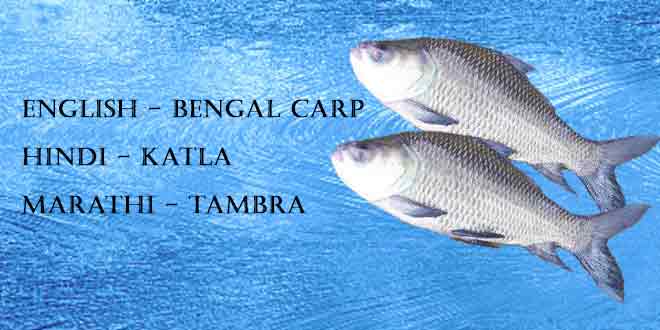
Katla is a fresh water fish that is widely found in the lakes and rivers of North India and Assam. A mature fish can attain an average weight of 2 kg. Katla is a very widely consumed oily fish. It is a rich source of protein and essential fatty acids.
Katla Nutritional Value per 100 grams
| Nutrient | Value |
| Protein | 23 grams |
| Omega 3 | 902 mg |
| Omega 6 | 663 mg |
| Cholesterol | 84 mg |
| Sodium | 63 mg |
| Potassium | 427 mg |
| Calcium | 52 mg |
| Vitamin A | 32 I.U. (1% of daily intake) |
| Vitamin B6 | 0.2 mg (12% of daily intake) |
| Vitamin B12 | 1.5 mcg (24% of daily intake) |
| Vitamin C | 1.6 mg (9% of daily intake) |
| Total Calories | 162 |
Katla has an Omega 6 to Omega 3 ratio of 0.7 which is good enough. It is a moderate mercury level fish. It contains somewhere between 0.09 to 0.20 ppm of mercury depending upon the environment. Moderate level means that the fish is safe to eat. You can couple it up with some low-level mercury fish to complete your weekly quota.
3) Rohu (Roho or Carpo Fish)
Protein per 100 grams: 17 grams
Total Unsaturated Fat: 1.4 gram
Mercury: 0.09 to 0.29 ppm (Moderate Level) 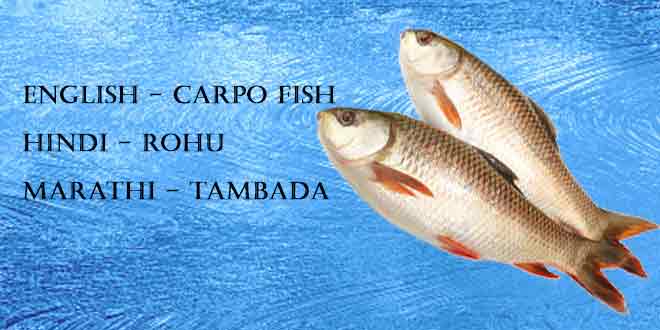
Rohu is also a member of the Carp family. It is a freshwater fish that is widely available in Northern as well as Central India. Due to the fish attaining an average weight of up to 2 kilograms, the fish is widely consumed for its meat. However, being an oily fish, it is rich in Omega fatty acids too.
Rohu Nutritional Value per 100 grams
| Nutrient | Value |
| Protein | 17 grams |
| Omega 3 | 1 gram |
| Omega 6 | |
| Cholesterol | 0 mg |
| Sodium | 97 mg |
| Potassium | 9.3 mg |
| Calcium | 52 mg |
| Vitamin A | 5% of daily intake |
| Vitamin B6 | 0.3% of daily intake) |
| Vitamin B12 | 0% |
| Vitamin C | 30% of daily intake |
| Total Calories | 97 |
Rohu is one of the best options for Indians as it is easily available at affordable rates. The ratio of Omega 3 to Omega 6 is almost 1. Just like Katla, this one too, is a moderate mercury level fish and therefore is safe to eat.
4) Bangda (Indian Mackerel)
Protein per 100 grams: 17 grams
Omega 3: 2646 mg
Mercury: Less than 0.09 ppm (Low Level)
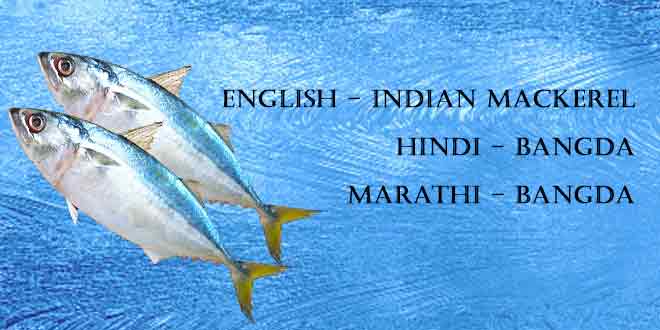
Indian mackerel or Bangda as it is popularly called is one of the staple fishes of India. It is a salt water fish that is widely found in the Indian Ocean and the surrounding seas. Mackerel is an oily fish and therefore is a good source of Omega 3 in addition to protein.
Bangda Nutritional Value per 100 grams
| Nutrient | Value |
| Protein | 18.6 grams |
| Omega 3 | 2646 mg |
| Omega 6 | 219 mg |
| Cholesterol | 75 mg |
| Sodium | 90 mg |
| Potassium | 314 mg |
| Calcium | 12 mg |
| Vitamin A | 167 IU |
| Vitamin D | 643 IU |
| Vitamin B12 | 8.7 mcg |
| Vitamin C | 12 mg (1% of daily intake) |
| Total Calories | 205 |
The fish has an Omega 6 to Omega 3 ration of less than 0.1 i.e. it is very rich in Omega 3. It is also a great source of protein. The best part is that it is a very reasonably priced. Mackerel is a low mercury level fish and hence can be enjoyed everyone.
5) Rani (Pink perch)
Protein per 100 grams: 25 grams
Omega 3: 375 mg
Mercury: Less than 0.09 ppm (Low Level)
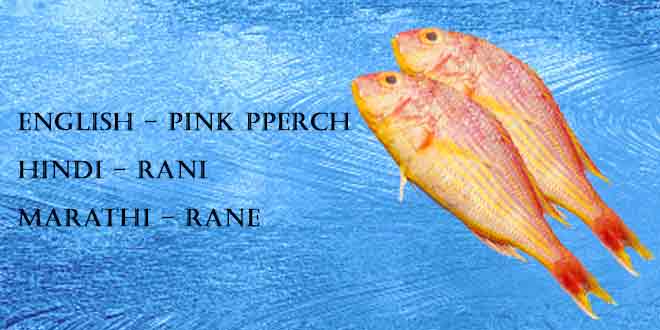
Ran is yet again a very commonly sold freshwater fish in India. Characterised by the pink colour, the fish is small in size with a mild flavour when cooked. The fish is not an oily fish i.e. it has less than 5 percent body fat and hence it is called as lean fish. A good contender, if protein is your sole criteria for having fish.
Rani Nutritional Value per 100 grams
| Nutrient | Value |
| Protein | 25 grams |
| Omega 3 | 375 mg |
| Omega 6 | 14 mg |
| Cholesterol | 115 mg |
| Sodium | 79 mg (3% of daily intake) |
| Potassium | 257 mg (26% of daily intake) |
| Calcium | 102 mg (10% of daily intake) |
| Vitamin A | 32 IU (1% of daily intake) |
| Vitamin B12 | 2.2 mcg (22% of daily intake) |
| Vitamin B6 | 0.1 mg (1% of daily intake) |
| Total Calories | 205 |
Pink Perch is high in protein and is low on mercury. It is a great choice for athletes who are looking for a dense protein source. Since, it is not an oily fish; it is moderate in terms of Omega 3 supply. Yet again, Rani is a very reasonable priced fish in India due to its abundance. You can definitely have Rani at least twice to thrice a week.
6) Surmai (Seer Fish / King Mackerel / King Fish)
Protein per 100 grams: 26 grams
Omega 3: 423 mg
Mercury: More than 0.7 ppm (Highest Level)
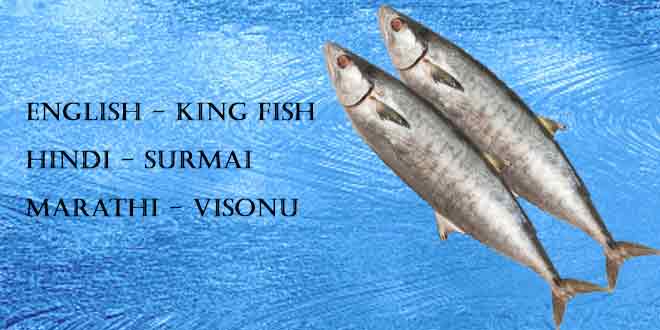
Surmai is one of the most popular and among the costliest fishes in India. It is more popular in South and Central India. Kerala, Tamil Nadu, Andhra Pradesh etc. treat Surmai as a delicacy. Categorically, Surmai is a type of mackerel and is called “King Mackerel” or “Indo-Pacific Mackerel”.
Surmai Nutritional Value per 100 grams
| Nutrient | Value |
| Protein | 26 grams |
| Omega 3 | 423 mg |
| Omega 6 | 51 mg |
| Cholesterol | 68 mg |
| Sodium | 203 mg (8% of daily intake) |
| Potassium | 558 mg (16% of daily intake) |
| Calcium | 40 mg (4% of daily intake) |
| Vitamin A | 839 IU (17% of daily intake) |
| Vitamin B12 | 18 mcg (300% of daily intake) |
| Vitamin B6 | 0.5 mg (26% of daily intake) |
| Total Calories | 134 |
As you can see, Surmai is rich in protein, good in Omega 3 and potent with respect to other minerals and vitamins. However, the fish has a notorious fame for being high on mercury. Now, this does not mean that you cannot have this delicious fish. Since there is a possibility, the vulnerable group should stay away from this fish. However, normal adults can have this fish once a week. Just ensure that if you have this fish, do not have any other fish in that week.
7) Paplet (Pomfret / Indian Butter Fish)
Protein per 100 grams: 18 grams
Omega 3: 1230 mg
Mercury: Less than 0.09 ppm (Low Level)
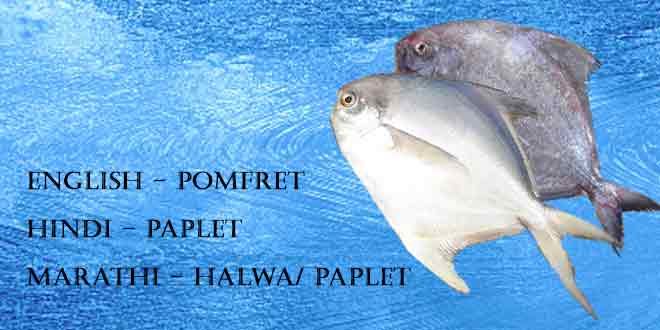
Paplet is again, one of the most exotically enjoyed fishes in India. Pomfret is a type of Butterfish that is widely found in South Asia including the Indian Ocean. Pomfret is a non-oily fish and has white meat which is highly delicious. Silver or white pomfret and black pomfret are the two most popularly sold fishes in India.
Paplet Nutritional Value per 100 grams
| Nutrient | Value |
| Protein | 18 grams |
| Omega 3 | 1230 mg |
| Omega 6 | 280 mg |
| Cholesterol | 83 mg |
| Sodium | 160 mg (6.3% of daily intake) |
| Potassium | 370 mg (11% of daily intake) |
| Calcium | 21 mg (2% of daily intake) |
| Vitamin A | 90 IU (1.8% of daily intake) |
| Vitamin B12 | 1.4 mcg (23.3% of daily intake) |
| Vitamin B6 | 0.3 mg (13% of daily intake) |
| Total Calories | 175 |
Paplet supplies a good deal of protein and omega 3. However, the fish is among the costliest fishes in India owing to its novelty. The white meat and rich flavour fetches a great price for this fish.
8) Hilsa (Herring / Indian Shad / Ilish)
Protein per 100 grams: 21 grams
Omega 3: 2418 mg
Mercury: Less than 0.09 ppm (Low Level)
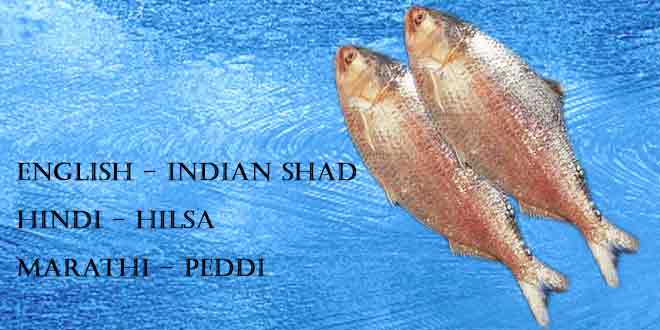
Who hasn’t heard about Hilsa? It is the most popular Bengali fish (national fish of Bangladesh) and very popular in Odisha, West Bengal, Assam, Andhra Pradesh, Gujarat etc. It is a delicacy not just in India but also all over South Asia.
Hilsa Nutritional Value per 100 grams
| Nutrient | Value |
| Protein | 21 grams |
| Omega 3 | 2418 mg |
| Omega 6 | 246 mg |
| Cholesterol | 99 mg |
| Sodium | 95.4 mg (4% of daily intake) |
| Potassium | 542 mg (15% of daily intake) |
| Calcium | 106 mg (11% of daily intake) |
| Vitamin A | 116 IU (2% of daily intake) |
| Vitamin B12 | 9.6 mcg (160% of daily intake) |
| Vitamin B6 | 0.5 mg (26% of daily intake) |
| Total Calories | 250 |
15% to 20% of the global Ilish catch is done by India. It is an oily fish and very rich in its Omega 3 content. The ratio of Omega 6 to Omega 3 is 0.1 which is great. It is delicious with tender meat. It is among the costliest fishes in India with cost per kg going up to INR 3000 usually. Hilsa is being highly fished and the population is gradually decreasing. So be wise and do not put Hilsa on your plate too often.
9) Kekda (Crab)
Protein per 100 grams: 21 grams
Omega 3: 2418 mg
Mercury: Less than 0.09 ppm (Low Level)
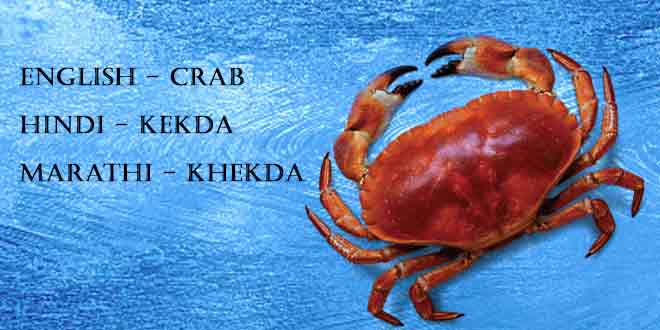
Kekda is not a fish but it is an integral part of healthy sea food list. Hence, we have placed it in this list. Another reason is that crab is available all over India easily and is enjoyed as a delicacy. Crab meat as healthy as any oily fish.
Kekda Nutritional Value per 100 grams
| Nutrient | Value |
| Protein | 24 grams |
| Omega 3 | 490 mg |
| Omega 6 | 8 mg |
| Cholesterol | 71 mg |
| Sodium | 691 mg (29% of daily intake) |
| Potassium | 200 mg (6% of daily intake) |
| Calcium | 33 mg (3% of daily intake) |
| Vitamin A | 173 IU (3% of daily intake) |
| Vitamin B12 | 10.4 mcg (173% of daily intake) |
| Vitamin B6 | 0.2 mg (9% of daily intake) |
| Total Calories | 115 |
Crab is a treat in every way. The meat is delicious, tender and healthy. Another important nutrient that crab is rich in is Selenium (44.4 mcg per 100 grams). Selenium has a protective function on the brain and counteracts the hazardous effects of mercury. Crab is easily available and moderately priced too.
10) Jhinga (Prawns and Shrimps)
Protein per 100 grams: 21 grams
Omega 3: 2418 mg
Mercury: Less than 0.09 ppm (Low Level)
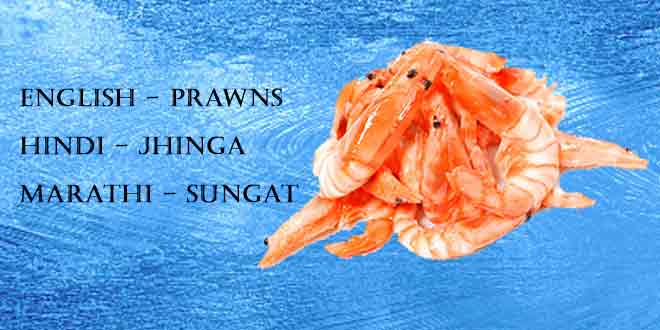
Although prawns and shrimps are different, they are very commonly referred to as jhinga in India. Even across the globe, prawns and shrimps are addressed interchangeably. Both can be found in fresh as well as sea water. Both almost have the same tastes and flavour. The major difference is that prawns are larger in size than shrimps.
Jhinga Nutritional Value per 100 grams
| Nutrient | Value |
| Protein | 21 grams |
| Omega 3 | 347 mg |
| Omega 6 | 21 mg |
| Cholesterol | 195 mg |
| Sodium | 224 mg (9% of daily intake) |
| Potassium | 182 mg (5% of daily intake) |
| Calcium | 39 mg (4% of daily intake) |
| Vitamin A | 173 IU (3% of daily intake) |
| Vitamin B12 | 1.5 mcg (25% of daily intake) |
| Vitamin B6 | 0.1 mg (6% of daily intake) |
| Total Calories | 99 |
Jhinga is also a rich source of iron (3.1 mg per 100 gram) and selenium (39.6 mcg per 100 gram). The best part about prawns or shrimps is that they are widely available in any local market at pretty affordable prices.
So these are the ten best fishes that can not only treat you to a protein rich meal but also enhance your overall health – both physical and mental. Fish is a highly nutritious and beneficial meal. So get your familiy, especially your young ones, to start savouring sea food regulalrly. Fish is a preferred protein rich food that is not only dense in nutrition but also a delectable choice when it comes to diet of athletes and bodybuilders.
 IBB – Indian Bodybuilding IBB – Home of Indian Bodybuilding and Fitness
IBB – Indian Bodybuilding IBB – Home of Indian Bodybuilding and Fitness





sir my weight is 68 and age 19 … plzz suggest a good protein for me which do not increase my fat more only improve my muscles shape and also size
try amino acid and hit the gym regularly.
Sir pls tell me seer fish is harmful
What about the nutritional content and mercury levels in sardines?
What is the protein content of yellow eel (pili vam)?
u missed mathi or sardines
Sir what are the bengali name of Indian Mackerel , and Rawas ? Can I get it kolkata market?
Sorry, we do not know the bengali name for Indian Mackerel and Rawas